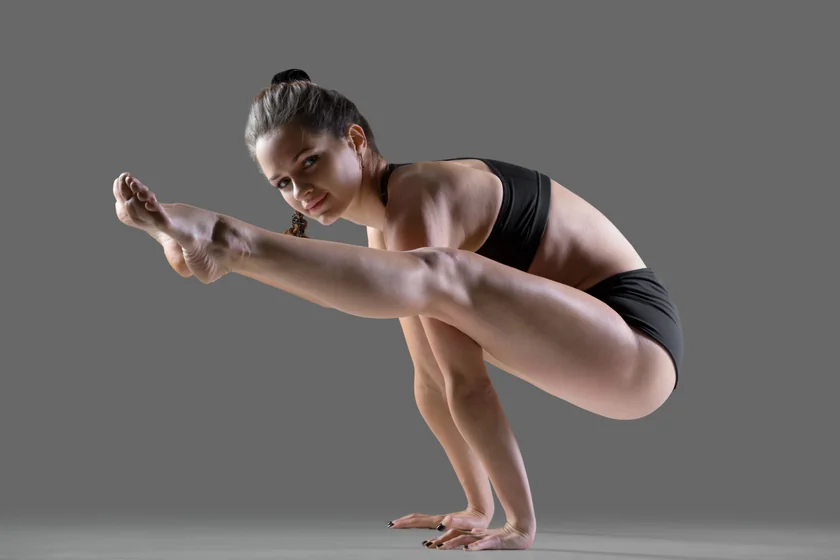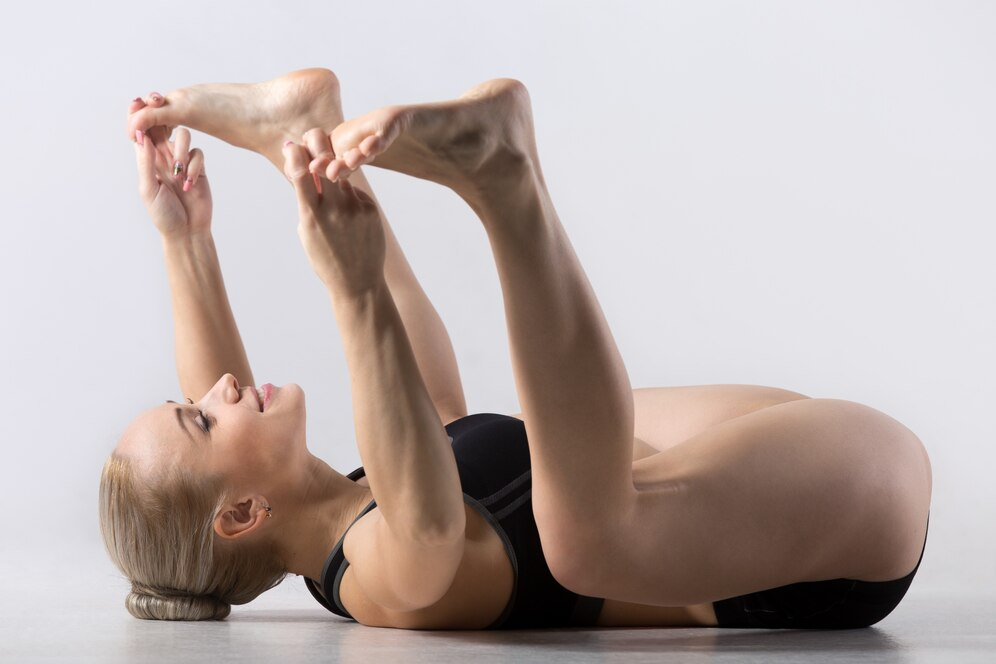What is Tittibhasana (Firefly Pose)?

The Tittibhasana or Firefly pose is an intermediate-level arm balance posture from Hatha yoga. It is also part of the second Ashtanga Primary Series and can be included in yoga flow sequences to boost energy flow through the body.
The Firefly Pose challenges one's arms and core strength, as well as helps to open-up tight hamstrings and glute muscles.
Tittibhasana is not considered the right starting point for an arm balance routine. But it can still be mastered with regular practice and the right guidance; stay tuned to learn more.
Overview & Etymology
Tittibhasana emerged from a combination of two Sanskrit words, ‘Tittibha’ meaning firefly, and ‘Asana’ meaning pose or posture.
Tittibhasana is stated as an intermediate-level yoga pose in Ashtanga vinyasa yoga. While in B.K.S. Iyengar's book Light on Yoga, Tittibhasana is mentioned as Dwi Hasta Bhujasana, which is an extended advanced version of the Hasta Bhujasana.
In Hindu Mythology, the origin of Tittibhasana is linked to the folklore of a pair of Tittibha birds. Once a female Tittibha was scared to lay her eggs near the sea, but the male was adamant, so she did it anyway.
The ocean overheard this and decided to teach the birds a lesson by simply washing their eggs away. The grieving couple went to Lord Garuda (bird king)—who prayed to Lord Vishnu and requested him to return the couple's eggs.
The petrified ocean did not want to face the supreme god's wrath. Thus, he had to return the couple's eggs.
The fable is often used in yoga as a metaphor. Here, the sea represents illusion and ignorance, and the Tittibha (insects) represents the yogi's faith.
Just as the tiny Tittibha couple triumphs over the mighty sea, a yogi's regular practice can neutralize and control their Chitta (aspects of ego consciousness) and help them attain ultimate balance in life.
Sanskrit Name: टिट्टिभासन Pronunciation: TEE-tee BAH-sah-nah
Pose Type: Arm Balance Also known as: Firefly Pose
Strengthens: Arms, Wrists, Core, Shoulders, and Upper Back
Stretches: Legs, Core, Shoulders, and Traps
Health Benefits of Tittibhasana
Improves core balance.
Enhances mental focus.
Boosts flow of Parana (energy).
Reduces stress and depression.
Increases wrist and arm strength.
Activates the hamstrings and glutes.
Activates Manipura Chakra (Solar Plexus).
Tones your arms, shoulders, and upper back muscles.
When to Avoid Performing Tittibhasana
Avoid after surgery.
Avoid if you have hernia.
Avoid if you have a severe injury.
Avoid if you have elbow or wrist arthritis.
Avoid if you have chronic low back pain.
Avoid during pregnancy and the menstrual cycle.
Avoid if you have tension in your neck, spine, or upper back muscles.
How to do Tittibhasana (Firefly Pose)
Tittibhasana requires immense power in your wrists, shoulders, upper back, and core to balance the arm. Whereas for the hip-opening transition, the practitioner's lower body should be thoroughly warmed-up.
So first, we’ll guide you through some warm-up poses and then gradually move on to the main posture steps and relax sequence.
Finally, get some easy Firefly Pose variations and modifications to customize your practice as per your comfort level.
Once you feel ready, roll down your yoga mats, and let's jump right into the firefly yoga posture.
Part 1 - Preparatory Poses for Tittibhasana
Activate blood circulation in your core, arms, wrist, and lower body with the following preparatory poses:
1. Phalakasana (Plank Pose) - Come on to your hands and knees in a tabletop position. Spread your fingers widely apart and keep your palms connected to the ground as you extend your legs out behind you.

Tighten your core muscles, engage the shoulders and hold the plank position for a few minutes. This pose will help you activate your arms, upper back, wrist, and shoulder while improving core balance at the same time.
2. Navasana (Boat Pose) - Navasana will bring you more strength in your core for the firefly balancing act. Get in a comfortable seated position and stick both knees together.

Activate your muscles in the navel and pubic bone, lift both feet off the mat, bring your tights closer to your chest, flex your arms in front, and find your balance in this boat-like position.
3. Surya Yantrasana (Compass Pose) - Begin in a seated position and bring your right leg close to your chest. Thread your right arm under your right leg, so your right knee is stacked over your right shoulder.

Place the right palm on the mat and with the left palm, hold your right foot. Finally, inhale slowly and start to lengthen your right leg straight up like a compass needle.
Repeat on the other side to prep up your hamstring, glute, and quad muscles for the main pose.
Part 2: Step-by-Step Instructions to Perform Tittibhasana
The following are steps to practice the Tittibhasana A or Firefly Pose A variation:
Step 1 - Start with a forward fold position and take 5-10 deep breaths in this stance.
Step 2 - Now slide your arms through the gap between your legs to align your hands right behind your heels.
Step 3 - Place your shoulder right behind your knees. While doing this, spread your palms on the ground and grip the yoga mat tightly with your fingers.
Step 4 - Start to lower your glutes such that your thighs are resting on the arms, palms are pressing into the mat, and feet are placed flat in front of your palms.
Step 5 - Next, inhale deeply, shift your gaze to the front, lift your feet one by one off the ground, and extend the legs straight.
Step 6 - Make sure as you start to balance in the firefly position, your core must be engaged, your collar bone is broad, and your thighs are squeezing the torso well. Hold this pose for a couple of seconds.
Step 7 - Exit by bringing your feet back to the ground one at a time and exhale deeply. Relax in the forward fold position for a few deep breaths and finally release.
Breath Awareness:
Inhale - While engaging the core muscles and getting into the arm balance stage.
Exhale - Post-arm balancing act once you feel ready to exit the pose.
Inhale & Exhale - Before getting started with the pose, while holding the pose, and while relaxing post-practice.
Performance Duration for Beginners: Hold the firefly pose for 15 to 30 seconds.
Performance Duration for Advanced: Hold the firefly pose for 30 to 90 seconds.
Part 3: Things to Keep in Mind
If you are performing the firefly pose for the very first time, it’s good practice to keep the following posture cues in mind:
Don’t rush it: If you are following all the steps, still unable to balance, the reason could be a lack of breath coordination. Beginners rush into the balancing act so fast they forget to coordinate their breath as they transition.
Tittibhasana is a challenging act, so rushing this posture will only negatively affect your practice. Hence, make sure you take your time at each phase—be it warm-up, the main stance itself, or the cool-down phase.
Grip the mat: Beginners can find the firefly pose challenging due to their wrong hand grip as well. If your fingers are glued, they won’t help you grip the mat.
To fix this, spread your fingers wide and first press the base of your palm into the ground, followed by your fingers doing the same.
A good grip will serve as an excellent base to balance while keeping your wrist safe from injuries.
Be mindful and exit: Feel like your shoulders are under pressure, your wrist is shaking too much, or your neck is hurting—simply exit.
Anytime you feel uncomfortable, withdraw the pose right there because not being mindful of your pain can lead you to severe injuries.
Part 4: Relaxing Poses After Tittibhasana
It's natural to feel highly stressed and overwhelmed right after the firefly pose practice, so to rejuvenate and repair, try the following relax asanas:
1. Adho Mukha Svanasana (Downward Facing Dog Pose) - Exit from the firefly pose via forward fold position. Now, extend your feet backward such that your body makes a triangle top.

Slowly exhale as you flex your chest deep into the ground. Hold this pose for a couple of minutes, and you'll feel the shoulders, traps, arms, wrists, hamstrings, and spine re-energizing.
2. Ananda Balasana (Happy Baby Pose) - Still feeling tension in your spine and legs?—Lie down on your mat and bend your legs. Hold your feet with your palms and push your knees toward the ground to open your glute muscles.

Close your eyes and rock the body like a baby relaxing in the cradle. This pose will help you relax your whole body.
Tittibhasana Variations to Consider
Ease or advance your firefly pose practice with the following posture variations:
1. Bhujapidasana (Firefly Pose With Crossed Feet): This is an excellent prepping variation for the firefly pose. Start from a squatting position and lean your upper body forward. Thread your arms under your legs and make sure the legs rest over the shoulders.

Now, bend the elbows, grip the yoga mat with your palms, and squat down, engaging your upper body muscles. Finally, cross your feet over each other, tighten the core, press into your hands, and fully come into balance.
Hold this variation until you feel strong enough to lengthen your legs straight.
2. Tittibhasana B (Firefly Pose B): Advanced practitioners can perform the firefly pose variations as a yoga flow. Usually, this sequence consists of different firefly pose variations, like - Tittibhasana A, B, C, and D.

So, once you’ve mastered Tittibhasana A, transition into the forward folding position and gently begin to skooch your torso between your legs.
Finally, to stretch the lower body deep, reach your hands behind your back and interlace your fingers tightly. Advanced yogis can hold this variation for 1 to 5 minutes to enhance hip mobility and increase core balance.

Enjoy a Free 1-on-1 Session with a Coach!
Receive personalized guidance tailored to your unique fitness goals, live with a dedicated coach—no credit card required.
Frequently Asked Questions about Tittibhasana
Beginners with weak arms and unreliable core strength must avoid getting into Tittibhasana. Get into the firefly pose only once your muscles feel thoroughly warmed up, activated, and strong.
Tittibhasana is good for building strength, increasing focus, improving balance, and enhancing mind and muscle coordination.
Tittibhasana can be beneficial to many parts of the body, like the core, shoulders, wrists, forearms, back, triceps, and hip flexors. Additionally, it offers a deep stretch in the hamstrings, adductors, and outer hips, which helps in improving your lower body mobility and flexibility.
Phalakasana, Purna Navasana, Upavistha Konasana, Surya Yantrasana, and Bakasana are some excellent preparatory poses to master before you get into your Tittibhasana practice.
Try easing the pressure with your feet crossed or elbows slightly bent, or you can increase the tension with your feet pointing straight toward the ceiling. All these posture cues are some widely used variations for the Tittibhasana.
It’s best to avoid performing Tittibhasana if you have any pain or injury in your shoulders, wrist, forearms, or neck.
Senior citizens with back and spine pain, as well as women during pregnancy and mensuration, must avoid this pose altogether.



.webp)
%20(7).jpg)




